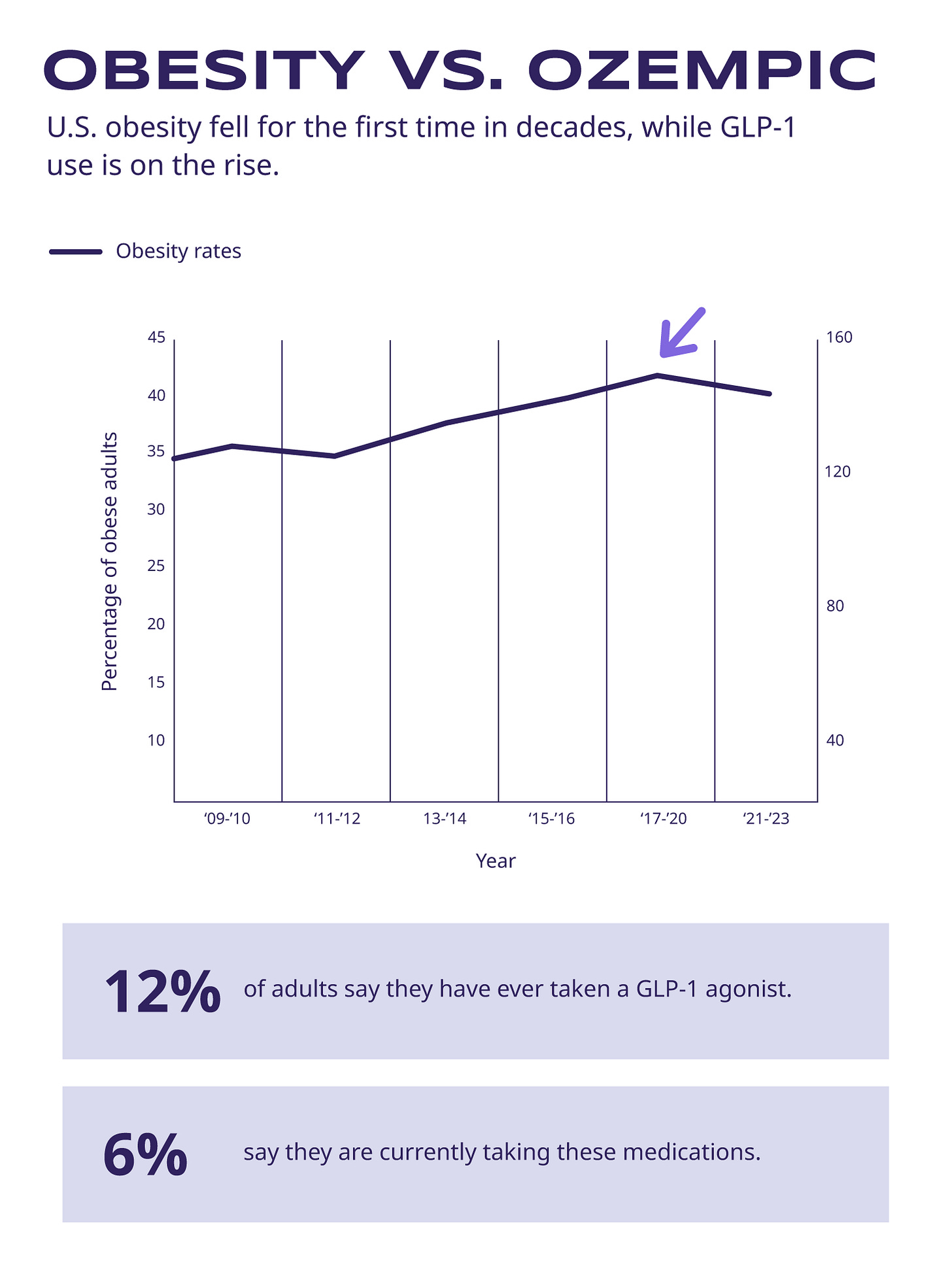What's Next, Now: October 2024
This month, our crystal ball predicts a grocery price showdown, a turning point for SaaS, the return of third places, and more.
This month, grocery retailers finally started reducing their prices. Well, at least some of them. Responding to a growing societal demand for affordability, Costco’s CFO announced the big box store is targeting lower prices, while Kroger introduced substantial reductions on over 200 items. These moves come as inflation continues to strain household budgets, leading to heightened consumer awareness and sensitivity to grocery pricing. Budget retailers such as Aldi and Trader Joe's are also thriving, capitalizing on people seeking both affordability and quality in their grocery shopping experience.
But Gen Z's affinity for aesthetically pleasing grocery experiences (influenced by social media hauls, pantry restocks, and “fridgescaping”) is driving growth at higher-end stores like Erewhon and Whole Foods — showcasing an evolving and contrasting consumer experience. According to a recent survey from McKinsey, groceries are Gen Z’s favorite place to spend a little extra cash. The survey asked over 4,000 respondents what they planned to splurge on this year, and groceries ranked number one for Gen Z — above restaurants, bars, travel, beauty and personal care, apparel, and fitness.
As economic pressures continue to shape consumer behavior, grocery chains will need to balance pricing along with shopping preferences. Shoppers will have to keep an eye on how grocery chains respond to inflation and whether recent price reductions will become the norm or if it might be a temporary fix. Many are also asking for more transparency when it comes to grocery prices as shoppers want to be able to predict and prepare their budgets effectively.
For grocery retailers, this could be a pivotal moment to retain customer loyalty and trust. Stores should assess both pricing strategies and marketing approaches to meet the shifting demands of their clientele.
The promise of artificial intelligence has been immense — and so has the investment. In Q3 alone, investment in generative AI startups reached nearly $4 billion. But not every industry sees promise from the AI boom. For software-as-a-service, or SaaS companies, some see the rapid adoption of AI posing a significant threat to ongoing business.
A recent Forbes contributor put the matter plainly: he believes AI may spell the end of the SaaS era. Currently available generative AI tools make software development more accessible, eating into software companies’ business models.
But like many AI-focused predictions, only time will tell how these two tech industries will fare head-to-head. And like many other AI superlatives, it’s more likely that savvy software companies will adapt and learn how to work alongside generative AI instead of resisting its ascendance. Some analysts foresee a transition into a “service as a software” model, where AI-driven agents perform services on behalf of customers.
AI agents throw another wrench in the works. Agentic AI, or artificial intelligence that is able to autonomously plan and complete actions, moves beyond the prompt-driven generative AI of tools like ChatGPT. Top AI providers from OpenAI and Anthropic to Salesforce and Microsoft have all recently announced competing AI agent services.
Agentic AI is still on the bleeding edge, so SaaS clients may not be seeking service-as-a-software any time soon. But keep an eye on how these tools grow and develop in your industry — sooner or later, the robots might be taking over, and you’ll need to adapt accordingly.
In 2020, we all got told to go home and stay inside. Since then, we haven’t gone back outside.
That’s a bit of an exaggeration. But a recent study started making headlines this month when it found that Americans were spending significantly more time at home and alone. This trend started long before quarantine, but just like every chart showing a growing trend from before the pandemic, the data spikes up in 2020. Over the last 20 years, time at home has jumped 10% — equivalent to one hour and 39 minutes. For Gen Z and Millennials, that time increases to two hours.
Growing alongside our time spent at home is another trend: the decrease in third places. “Third places” refers to those outside the home (place one) and the workplace (place two) where you can spend time with other people, ideally without spending a lot of money — think parks, cafes, or libraries. Losing spaces to be with other people offline has its consequences: What’s been referred to as a “loneliness epidemic” is currently making its mark on workers and Americans of all ages.
It’s not all doom and gloom. People are making an effort to get offline and out of the house. Offline dating, for example, got a boost this summer as people looked for ways to meet each other IRL. And brands are taking notice and offering their own alternatives. Starbucks recently announced a new strategic direction, pivoting away from mobile orders and hyper-customization to offering a place for people to come together and drink coffee, while Free People has started to open gyms as an extension to its popular activewear brand. A brand-led revival of third places could fill a gap and lead to a reversal of the couch-culture trend.
This summer, we examined how the rapid development of AI is driving energy demand. In recent months, tech companies have continued in their commitment to advancing AI by investing in cloud infrastructures around the globe. In September, an alliance was formed among BlackRock, Microsoft, and other partners to establish the backbone of future AI infrastructure (namely: huge, energy-hungry data centers.)
While there is pressure to expedite this development in order to keep up with technology, concerns about sustainability remain. Microsoft CEO Satya Nadella emphasized that this initiative seeks to “bring together financial and industry leaders to build the infrastructure of the future and power it sustainably.” More companies are joining in on this investment, as other major tech firms have announced their global AI infrastructure projects in countries including Malaysia, Italy, and Thailand.
The recent emphasis on a global approach to AI extends beyond infrastructure development. In late September, the U.S. Department of State announced The Partnership for Global Inclusivity on AI (PGIAI), uniting the Department of State with tech leaders including Amazon, Anthropic, Google, and NVIDIA. This partnership aims to combine their expertise and resources to harness AI for sustainable development in developing countries, while ensuring AI systems are safe and trustworthy.
For AI to continue to advance, there will need to be more collaboration at a global level. From infrastructure development to global company commitments, we’ll see ongoing conversations on how to innovate while maintaining a sustainable and inclusive approach. Making sure AI developments don’t widen the technological divide will be a top priority for AI critics and enthusiasts alike.
Earlier this month, fresh CDC data revealed obesity rates in the U.S. fell after decades of increasing prevalence. Headlines proclaimed that, perhaps, Americans have passed peak obesity. Many also connected this public health milestone to the increasing availability, efficacy, and awareness of GLP-1 agonists like Ozempic, Wegovy, and Zepbound.
Add it to the slowly but steadily growing list of benefits from what is increasingly looking like a miracle drug. Over the past year, GLP-1 drugs have been shown to potentially reduce or treat:

Earlier this year, only 16% of Americans believed drugs like Ozempic would have a significant impact on obesity. But with this new data, public opinion on the potential for GLP-1s could face a dramatic shift.
While many of the long-term effects of these medications remain unknown, their short-term promise could encourage wider adoption and approval for applications outside obesity and diabetes. Then comes the supply question: Many of these medications have experienced extended shortages as demand surged over the past year. In response, compounding pharmacies were able to fill the supply gap, increasing access. But earlier this month, the FDA declared an end to the shortages, and in turn to the production of compounded products. Now, compounders are firing back with a lawsuit.
Limited insurance coverage and high costs may be preventing interested patients from accessing these medications. But if compounded GLP-1s remain on the market (or if brand-name prescription costs come down), the impacts we’re starting to see on public health could continue to increase. Various industries are bracing for impact. The food industry may feel like an obvious early responder, but alcohol and tobacco companies will likely need to adapt, too. (Who knows, even your pets may be taking these medications soon.)
For companies in the medical industry, it will become increasingly important to learn how to serve the unique needs of patients and clients taking these medications. And as we enter a new era of weight loss and management, communications around food and diet will need to become more nuanced across industries.
It’s not just the toy shelf getting a kidult makeover. Consumers are also bringing the kids menu to the adult table.
Google’s NotebookLM is the latest AI tool to catch marketers’ eyes with its instant podcast generator. We tested the tool out on some of our own content to see if it's worth adding to your content stack.
Just like how Halloween is creeping earlier and earlier onto retail shelves, consumers are getting an early start on another holiday tradition — New Year's resolutions. Whether you’re hearing it referred to as the October Theory or your “winter arc,” some people are seeing the start of the winter season as a time to reassess priorities and work toward goals with renewed energy.
Want to hear more? Explore the Tier One blog, TOP TALK, for the latest digital marketing trends, tips, and insights.
Copyright © 2024 Tier One Partners is a women-owned full-service PR, content, and digital marketing agency. We work with innovators in B2B and B2C technology, digital healthcare, financial services, energy tech, and manufacturing to develop award-winning creative, data-driven strategies that propel them to industry leader status. From day one, we’re committed to earning our clients’ trust, sharing their vision, and embedding their purpose into everything we do. To learn more, visit wearetierone.com.


















